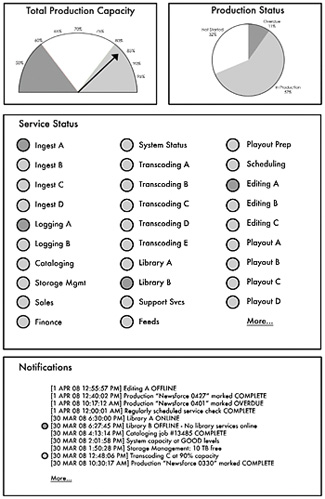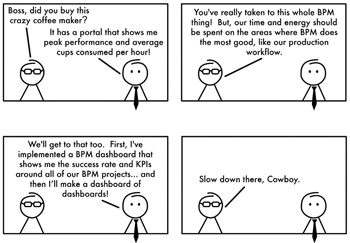I Can See Clearly Now!

"Having knowledge but lacking the power to express it clearly is no better than never having any ideas at all," the ancient Greek statesman Pericles said.
Perhaps one of the more common complaints I hear is about the inability to present clearly the massive amounts of information that are generated on a daily basis. It seems to be a universal complaint throughout the organization.
Whether it is management trying to understand productivity, or an editor trying to understand assignments, or an engineer wanting to see what is going on with the systems, everyone is clamoring for more visibility.
USING A DASHBOARD
Traditionally, this is done in a number of ways. It is very common to see a plethora of spreadsheets used in different departments to track what is going on. This is actually quite effective within a small department, but is problematic even there. Editing errors, lack of enforced updates, and more can mean trouble. The spreadsheet is also often inadequate when dealing with information that needs to cross departments.
Perhaps the most effective means of visibility I have seen used in organizations is the whiteboard. A whiteboard provides a display of information that is easily visible and understandable to teams. Of course, it requires manual updating and it is tough to ship the whiteboard to another department or management for reporting!

Fig. 1: Mocked-up dashboard In IT, there is an equivalent concept to the whiteboard—the dashboard, (Fig. 1). A dashboard is a monitoring user interface that presents disparate business to the user in a unified way. They are useful in presenting information from many systems in one place.
Many dashboard solutions will feature graphical lights, gauges, and graphs. The biggest advantage of this over the whiteboard is that it is dynamic. It can display the information as it comes in and often provides tools that allow a user to view the data in different ways.
System monitoring is an important form of dashboard that is sometimes seen today in facilities. Many facilities will have one or more applications that can be used to monitor technical systems. Unfortunately, they often have several. It is common to see different screens for signal monitoring, IT equipment monitoring, satellite monitoring, facilities monitoring, and more.
It is very difficult for one person to keep track of what is happening on all of these screens. You can build monitor walls with the data displayed, or provide KVM switches, but it is the rare technology department that is able to assign someone to simply watch the screens.
Many technologies allow you to set up alerts such as e-mails, but these are sometimes configured badly such that they only contribute to information overload with constant, less-than-relevant alerts.
The advantage of an integrated system is that it not only consolidates the many disparate screens to one or a few, but it can be set up with logic that allows it to understand what is important by looking at the systems holistically. It can understand that the upstream failure of a device is the core cause of the problems and filter its alerts to what is most relevant.
Additionally, it can provide integrated logs. What engineer has not been frustrated by the requirement of needing to manually look through and correlate multiple logs in order to troubleshoot an unusual failure?
Another common requirement is operational visibility. It is less common, however, to see IT-based solutions in this area in media facilities. There is no reason, however, that an integrated result can can't be achieved with business and operational systems. There are a number of IT technologies out there that help with integrating information from multiple systems.
Business Activity Monitoring (BAM) is used in architectures such as Service-Oriented Architecture (SOA) that use Business Process Management (BPM) to represent business-level data in the system's infrastructure. BAM technology aggregates business data such as process metrics and Key Performance Indicators (KPIs) and presents this data to authorized users.

Fig. 2: The Boss and You--Dashboard Bonanza! Credit: 2009 Focal Press/Artist: Joey Faust A portal is an enterprise component that is useful for organizing data from multiple sources in a single user interface. Portals use portlets as fundamental presentation components. Portals can display dashboards, task lists, administrative interfaces, and other views to users. They can also display mash-ups, which are Web-based applications that leverage (through service calls) the functionality of two or more underlying business applications. These can be used to produce hybrid functionality without a lot of original programming.
ROLE-BASED VIEWS
What is perhaps one of the most interesting features of dashboards is the ability to make the views role-based. The CEO of the company can have a view that deals with high-level business metrics. The vice president of operations can have detailed operational information (Fig. 2), while the vice president of technology has a view focused on the systems. An individual line worker can have views that focus on their tasks and all of the related information they need to do their job day to day.
This is important stuff. Succeeding at the challenges in visibility is key to making a successful organization in the media space. Knowing what is happening with your systems is how you make sure your facility stays up and making money with maximum efficiency. Knowing how the business is doing is critical to knowing where to make improvements and measuring how effective your changes are.
Increasing visibility through dashboards is something to move toward now so you can chart that future. Inexpensive systems can be built out of open source if your budget isn't large. If you engage in dashboard projects that increase visibility you will have a significant and positive impact on your organization. You can Count on IT!
John Footen is a vice president at National TeleConsultants and the head of its Software Solutions Group. He is also co-author of the book "Service-Oriented Media Enterprise." He can be reached atjfooten@ntc.com.
The professional video industry's #1 source for news, trends and product and tech information. Sign up below.
With more than three decades of M&E experience under his belt, John Footen is a managing director who leads Deloitte Consulting LLP’s media technology and operations practice. He has been a chairperson for various industry technology committees. He earned the SMPTE Medal for Workflow Systems and became a Fellow of SMPTE. He also co-authored a book, called “The Service-Oriented Media Enterprise: SOA, BPM, and Web Services in Professional Media Systems,” and has published many articles in industry publications.

